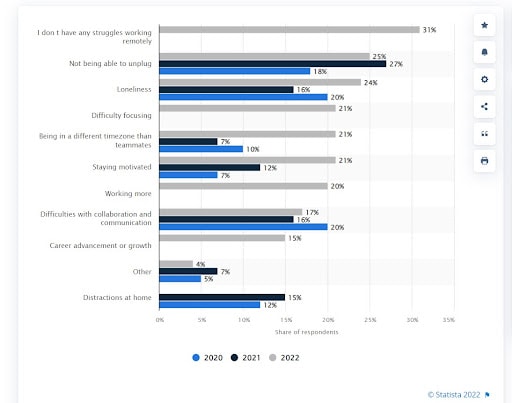In the wake of the COVID-19 pandemic, remote work and hybrid work models have become more common. While these models have many benefits, they also come with unique challenges for employers.
For example, how can you manage a distributed workforce effectively? How can you build a high performance remote work culture that fosters collaboration and productivity? And what are the legal considerations when it comes to remote and hybrid work policies and compensation?
This guide will explore the ins and outs of remote and hybrid work for employers. We’ll look at the advantages and challenges of these models.
We’ll also provide practical tips and best practices for managing a distributed workforce, leveraging technology and tools, hiring and onboarding remote workers, and much more. Whether you’re new to remote and hybrid work or looking to optimize your current practices, this guide has everything you need to succeed in the new world of work.
Advantages and Challenges of Remote and Hybrid Work
Remote and hybrid work models have become increasingly popular in recent years, thanks in part to advancements in technology that make it easier to stay connected with team members from anywhere in the world. Some of the key advantages of these models include the following:
- Greater flexibility: Remote and hybrid work allow employees to work from anywhere, anytime, making balancing work and personal commitments easier. This can lead to increased job satisfaction, better work-life balance, and higher employee retention rates.
- Cost savings: Remote and hybrid work can reduce overhead costs associated with maintaining a physical office space. This can include savings on rent, utilities, and other expenses.
- Access to a broader talent pool: With remote and hybrid work, employers can hire from anywhere in the world, giving them access to a larger pool of talent with diverse skill sets and backgrounds.
- Increased productivity: Some studies have found that remote workers are more productive than those who work in a traditional office setting. This may be due to factors such as fewer distractions, greater autonomy, and the ability to work during their most productive hours.
While there are many advantages to remote and hybrid work, these models also come with unique challenges, including:
- Communication and collaboration challenges: When team members work remotely or in different locations, communication and collaboration can be more challenging. Employers must find new ways to facilitate collaboration, such as through video conferencing, chat tools, and project management software.
- Technology and security concerns: With remote and hybrid work, new technology and security considerations must be kept in mind. Employers must ensure that their employees have access to the tools and software to do their jobs effectively while also implementing security measures to protect sensitive data and systems.
- Employee engagement and isolation: Remote and hybrid work can be isolating, which can lead to feelings of disengagement and burnout. Employers need to foster a sense of community and connection among team members through virtual team-building activities and regular check-ins.
Also Read: 10 Remote Working Tools You Need in 2023
Establishing Remote and Hybrid Work Policies
Now that you’ve decided to adopt a remote or hybrid work model, it’s essential to establish policies that support a successful distributed workforce. Clear and concise guidelines can help to prevent misunderstandings, ensure accountability, and keep employees engaged and productive. Here are some recommendations you may find helpful:
Communication and Collaboration Tools
Effective communication and collaboration are crucial to the success of a remote or hybrid work model. To ensure that your team can work together seamlessly, you’ll need to establish policies around the use of communication and collaboration tools. Here are some of the key considerations to keep in mind:
- Which tools will your team use for video conferencing, instant messaging, and project management?
- What are the expectations around response times and availability during working hours?
- How will you ensure that all team members are up-to-date and informed about project progress?
Performance Management and Goal Setting
With a distributed workforce, it’s crucial to establish clear expectations around performance management and goal setting. This helps ensure that everyone is working towards the same objectives and allows you to identify areas for improvement. Some key considerations include the following:
- How will you get feedback, measure and track performance for remote or hybrid employees?
- What are the expectations around goal setting and progress reporting?
- How will you ensure that all team members have the support they need to meet their objectives?
Compensation and Benefits
Compensation and benefits can be more complex in a remote or hybrid work environment. That said, it’s important to establish policies that are fair and equitable. Some key considerations you will want to look at include the following:
- How will you determine compensation for remote or hybrid employees?
- What benefits will you offer, and how will you ensure they are accessible to all team members?
- How will you address issues related to taxes and employment regulations in different locations?
Equipment and Technology Requirements
To be successful in a remote or hybrid work environment, your team members will need access to the right equipment and technology. It’s important to establish policies around equipment and technology requirements to ensure that all team members have what they need to work effectively. Some key considerations include:
- What equipment will your team members need, such as laptops or monitors?
- What software or technology will be required for communication and collaboration?
- How will you provide technical support to remote or hybrid employees?
Security Considerations
Remote and hybrid work arrangements can expose companies to increased security risks, and it is crucial to have proper security measures in place. Here are some security considerations to keep in mind when establishing remote and hybrid work policies:
- Secure access to company systems and data using VPNs and multifactor authentication.
- Implement strong password policies and educate employees on safe password practices.
- Regularly update and patch software and use antivirus and antimalware solutions to protect against cyber threats.
- Establish clear guidelines for handling sensitive data and ensure it is properly encrypted and stored.
- Always browse secured websites equipped with an SSL certificate like single domain, multi-domain, and wildcard SSL certificate. There are many SSL certs available at the lowest price like cheap single domain or cheap wildcard SSL and many others, providing a layer of encryption and protection for online communication.
Also Read: How to Collaborate Remotely
Hiring and Onboarding for Remote and Hybrid Work
Hiring employees working remotely or in a hybrid work environment requires a different approach than traditional hiring. It would be best if you looked for candidates with not just the necessary skills and experience but also the ability to work independently, manage their time effectively, and communicate well online. He are some recommendations to help you get started:
Adapt your Hiring Process
You need to adapt your hiring process to find the right remote or hybrid candidates. You can do this by:
- Clearly define the role, expectations, and communication channels in job postings.
- Using video interviews to evaluate candidates’ remote communication and collaboration skills.
- Using assessments to assess candidates’ ability to work independently and manage their time effectively.
Create a Comprehensive Onboarding Program
Onboarding is a critical process for new remote or hybrid employees. It is essential to ensure that new hires feel welcome, get up to speed quickly, and have the tools and information they need to succeed. Here are some tips for developing a comprehensive onboarding program:
- Prepare a detailed onboarding plan, including training materials, checklists, and timelines.
- Assign a mentor or buddy to help new hires get familiar with the company culture and connect with their colleagues.
- Provide access to necessary tools, software, and documentation, such as a virtual private network (VPN), project management software, and shared folders.
Make the Transition Easier for Employees
Transitioning to remote or hybrid work can be a challenging experience for employees, especially if they are used to working in a traditional office setting. Here are some ways to make the transition easier for your employees:
- Communicate frequently and openly to address concerns, answer questions, and provide feedback.
- Provide support and resources for employees to set up their home office and ensure access to a comfortable and ergonomically designed workspace.
- Create opportunities for remote employees to connect and build relationships with their colleagues through virtual team-building activities and events.
Emphasize Company Culture
Company culture is a critical aspect of remote and hybrid work. It is essential to maintain a strong and positive company culture, even in a distributed work environment. Here are some ways to emphasize company culture:
- Clearly define and communicate your company’s mission, values, and goals.
- Encourage and facilitate virtual team-building activities to promote a sense of camaraderie and connection among remote and hybrid employees.
- Celebrate successes and recognize achievements of remote and hybrid employees to reinforce a sense of belonging to the company.
Set Clear Expectations
Remote and hybrid work can blur the lines between work and personal life. Setting clear expectations around work hours, communication, and productivity is essential to avoid burnout and promote work-life balance. Here are some ways to set clear expectations:
- Clearly define and communicate policies around work hours, availability, and communication channels.
- Provide regular feedback and coaching to help remote and hybrid employees stay on track and meet performance expectations.
- Encourage and model healthy work habits, such as taking breaks, getting enough sleep, and maintaining a healthy work-life balance.
Also Read: Engagedly Developing Culture in the Remote Workforce
Final Thoughts
Navigating remote and hybrid work requires a deliberate approach that accounts for the unique challenges and opportunities that come with this mode of work. Engagedly can help by providing a platform for seamless goal setting and tracking, continuous feedback, performance evaluations, and employee recognition and rewards.
Also, Engagedly’s learning and development features can support ongoing employee growth and development, which is especially important in remote and hybrid work environments. By implementing the right policies, technology infrastructure, and communication strategies with the help of Engagedly, employers can create a conducive environment that supports high productivity, collaboration, and employee engagement, regardless of location.
So, if you’re looking to effectively navigate remote and hybrid work, consider leveraging Engagedly’s performance management software platform. Start your journey to success today!
Frequently Asked Questions
Q1. What is the difference between work from home and remote?
Ans. “Work from home” usually means an employee is working from their own home, while “remote” work can refer to working from any location outside of a traditional office, including coffee shops, co-working spaces, or other places. Remote work may also involve working for a company in a different location, with more flexibility in working hours and equipment use.
Q2. What is the difference between remote and in person work?
Ans. The main difference between remote and in-person work is the physical location where work is performed. In-person work typically takes place in a traditional office setting, where employees are expected to be present during specific hours and work closely with colleagues. Working remotely provides employees with the opportunity to work from various locations, such as their home or other places outside of the office. Remote workers have more flexibility with their schedule and often work independently, utilizing technology to communicate and collaborate with their team. This type of work can enhance work-life balance and eliminate the need for a daily commute, however, it also demands greater self-discipline and communication skills to remain productive and connected with colleagues.
Q3. What is an example of a remote employee?
Ans. An example of a remote employee would be a software developer who works from home for a company based in a different state or country. The developer communicates with their team and managers through email, messaging apps, and video calls. They have access to the necessary software and tools to do their job remotely, and are responsible for managing their own work schedule and productivity. Remote employees can work in a variety of industries and roles, including marketing, customer service, and project management, as long as their job can be performed outside of a traditional office setting.
Author: Grace Smith
Grace Smith is a content writer and social media specialist with six years of experience of working in start-ups, digital marketing and SEO. He can help you with your next business venture or social media campaign.
















 Image Source:
Image Source: 

 OKRs are one of the best methods of measuring
OKRs are one of the best methods of measuring  Planned-to-done ratio measures the number of tasks delivered by team members against the planned activities.
Planned-to-done ratio measures the number of tasks delivered by team members against the planned activities. 

 Image Source: McKinsey.com
Image Source: McKinsey.com










































